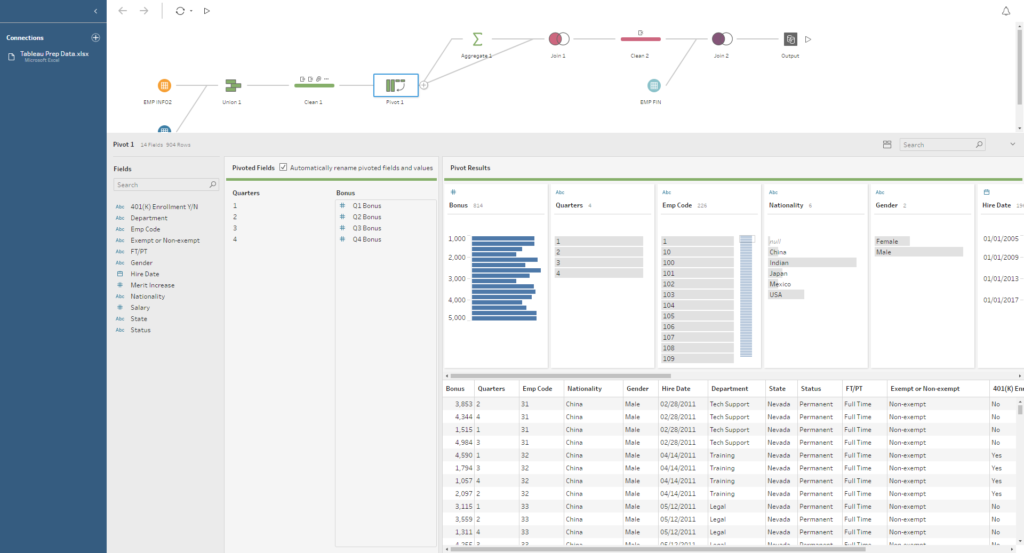
- #Tableau prep license cost license#
- #Tableau prep license cost free#
They might require it to make important decisions. Tableau Viewer: It is for users who need actionable insights.
#Tableau prep license cost license#
Further, it includes a license to Tableau Server or Tableau Online. On the other hand, if deployed in the cloud, it costs $42/user/month. Tableau Explorer if deployed on-premise costs $35/user/month. You can create new content only with the available data sources. It allows you to interact with visualizations through Tableau Server. However, it doesn’t allow you to create data connections.
Tableau Explorer: With Tableau Explorer, you can create content. Tableau Creator comes for $70/user/month. You get access to Tableau Desktop, Tableau Prep, and Tableau Server/Online. This might be for a business organization they work for. Further, these users will also create data sources. Tableau Creator: This is suitable for those users who need to create reports and dashboards from scratch. We will discuss these three plans in detail below: Now, we will discuss the pricing of Tableau. Overall, it is an economical way for organizations to train their Tableau users in a scalable and consistent way. It teaches you visualization authoring skills for Tableau Server. On the other hand, eLearning for Tableau Explorer costs $5/user/month (billed annually). It teaches you Tableau Desktop and Tableau Prep. E-Learning for Tableau Creator costs $10/user/month (billed annually). Regardless of what skill level you are on. With this Tableau training, you can learn Tableau. 
Tableau eLearning is a program offered by Tableau. Thus, Tableau training can be very useful for you. Tableau is used by various large businesses.
It is a secure and strong BI software, according to users. It provides real-time analysis of data. For example, you can customize the dashboard for mobile devices. Tableau allows you to customize the dashboard for specific devices. You can combine data from various data sources to create an interactive dashboard. Anyone without a non-technical background can use it. You can easily import or export a large amount of data. Listed below are some of the advantages of Tableau: It is used to visualize data in order to get actionable insights. On the other hand, Tableau Online hosts your data on Tableau. Tableau Server lets you store data in the cloud of your choice or your on-premises server. Only then you can share them on Tableau Server. However, you will need to first publish your workbooks on Tableau Desktop. Tableau Server: Tableau Server is an application that allows you to edit and organize Tableau Dashboards. Further, you can also share these dashboards. You can combine these visuals to create a dashboard. This is done in order get actionable insights out of raw data. Tableau Desktop: Tableau Desktop is helps in create charts, graphs, reports, etc. Basically, it is suitable for those who want to learn Tableau. You can connect it to CVS files, MS Excel, and text files. However, you cannot save the workbooks locally.Instead, it lets you save them in Tableau’s public cloud. It lets you create visualizations just like Tableau Desktop. 
#Tableau prep license cost free#
Tableau Public: Tableau Public is the free version of Tableau Desktop.Tableau Reader: It is a free desktop application that allows you to view the worksheets.You will need workbooks created in Desktop version to publish on Tableau Online. There is no storage limit for the data you publish. It is easily accessible through apps or websites. You can get new insights from the dashboards by interacting with them. Tableau Online: It is a Tableau sharing tool.Tableau Reader, Tableau Online, and Tableau Server fall in this category. Sharing Tools: These are the tools that help in the sharing of reports, dashboards, etc.Tools that come under this category are Tableau Public and Tableau Desktop. Developer Tools: Developer Tools are tools that help in creating reports, dashboards, etc.Each of the products of tableau has a specific function.

Now, we will discuss the Tableau Product Suite. You can also share data securely from on-cloud or on-premises sources. Another amazing feature of Tableau is that it allows you to share data with others. Such as MS Excel, PDFs, MySQL Server, Oracle, and many more. Moreover, you can connect Tableau to 40 data sources. The visualizations that you create are in the form of dashboards and workbooks. You don’t need to know programming to make interactive visuals in Tableau. Companies such as LinkedIn, Amazon, and Ferrari use Tableau for visualizing data. It is used to convert raw data into meaningful and understandable data. Tableau is Business Intelligence (BI) tool.







 0 kommentar(er)
0 kommentar(er)
